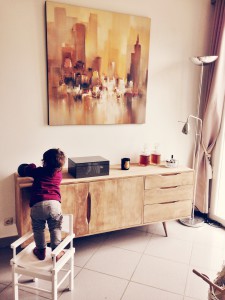 When you are expecting to take in a foster child, it is hard to know how to prepare. Similar to the feeling of being pregnant and waiting for the baby to come, waiting for a foster child evokes excitement along with some anxiety about the unknown. It is a time filled with anticipation about the future. Trying to figure out how to prepare your home for a new child can seem overwhelming, and you might not know where to start. Here is a list of ways that you can use to help prepare your home for a foster child:
When you are expecting to take in a foster child, it is hard to know how to prepare. Similar to the feeling of being pregnant and waiting for the baby to come, waiting for a foster child evokes excitement along with some anxiety about the unknown. It is a time filled with anticipation about the future. Trying to figure out how to prepare your home for a new child can seem overwhelming, and you might not know where to start. Here is a list of ways that you can use to help prepare your home for a foster child:
1) Set Up Your Living Space
Each state has different laws regarding the living quarters of foster children. However, most states require that your home has a bed for each child that you are licensed to accept. Decorate the foster child’s bedroom in a gender-neutral color and decorate the room with a simple yet cute aesthetic. There is no need to go overboard with the decorating, but adding a few small touches will make the foster children feel much more at home. The foster child will likely feel nervous upon first entering your home, but giving the child an inviting room to sleep in can assuage some of the child’s concerns. A small activity box with coloring books, crayons, a diary, books for various age ranges, a deck of cards, perhaps a puzzle or travel game. In sleepless nights or quiet times a little something to do can help the child settle in.
2) Stock Up On First Aid And Cold Remedies
When you take in a foster child, everyone in the household is getting acclimated to each other’s germs. Furthermore, everyone in the house will be stressed out, and some children who arrive are not in the best shape in terms of personal hygiene. With all of these factors combined, it is likely that people in the house will get sick. Make sure to stock up on over-the-counter fever reducers and pain relievers, as well as a thermometer. You also may want to consider buying lice medication just in case.
3) Lock Up Medications
In some places, licensing standards require foster homes to lock up medications, cleaning supplies, and other chemicals for the safety of the child. A good idea is to put these items in the closet and to put a “lock hasp” on the outside of your closet. A lock hasp is a metal hinge that can swing open and closed, and is locked by slipping a padlock through it. Lock hasps are easy to find at any hardware store and easy to install. You can also place any medications you take daily into a tool or tackle box that you are able to lock with a padlock.
4) Collect Clothing
Between the time you accept a foster child and the time the child shows up in your home, you won’t have much time. It is a good idea to buy some clothing preemptively, even if you don’t know the age and gender of the child. The only way to solve this is to buy clothing for each size and gender that you are open to accepting, as well as clothes one size bigger and one size smaller in case the child runs large or small. Gender neutral sweatshirts and t-shirts can make this less of an expense and chore. A good idea is to get a small plastic bin for each size and gender combination and mark the boxes accordingly. You should have around two daytime outfits and one or two sets of pajamas for each size and gender combination. It is also a good idea to buy a few pull-on style training diapers. If you have a friend with children, you can ask to take a handful of pull-up diapers out of a package, and don’t be shy about collecting well cared for hand-me-down clothing. You will need more of all of these items, obviously, and it’s nice to cater to the children’s taste when you know them, but this will buy you some time in the case they show up in a hurry.
5) Keep Snacks on Hand
Foster kids are almost always hungry. Some of them horde food, because they don’t know where the next meal may come from. It can be frustrating for new foster parents who feel like children are stealing food, but it’s a survival instinct. Having a low cupboard, or basket on the table, constantly full of non-perishables in healthy varieties (or at least not junk-food) like applesauce cups, fruit leather, single-serving packages of nuts or granola, and peanut butter filled pretzels will make the child feel safer that there is always food available to them. And those types of food won’t go bad if they are hidden away in a room somewhere. Pediasure or Ensure in the fridge lasts for a while if the child shows up dehydrated or undernourished. A few extra meals in the freezer or an extra box of pasta and jar of sauce on hand can help with a last minute dinner that is bigger than expected.
6) Be Sensitive and Understanding
What is most important is to approach this moment with caution and sensitivity. Do not build up any expectations regarding how the foster child will react upon meeting you. It is important to remember that all foster children react differently when first meeting their foster parents, and that you should never judge a foster child based on the way they react when they meet you, how they appear, or anything else. Remember that the child has just lost his or her familiar pattern of living, and no child goes into foster care under happy circumstances. No matter how bad the child’s previous situation was, the child may at first want his or her original parents back. Regardless of how a foster child arrives, the child requires your love and care.
Taking in a foster child is not easy, but it is extremely rewarding. While there are challenges that are bound to come up when you bring a new foster child into your home, following these tips will take away some of the stress. If your home is prepared for a foster child, then you will feel more equipped to care for the child, and your experience will be a lot easier. Making your experience easier now will help you devote that extra time to changing the life of a child who needs your care.
